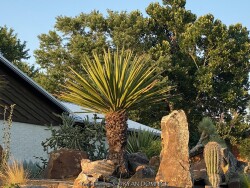

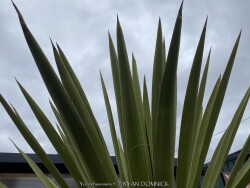
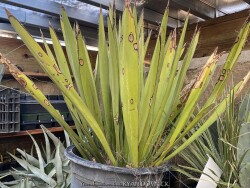
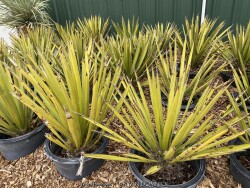
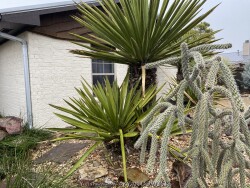
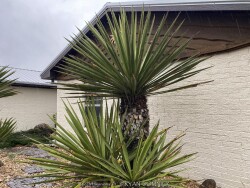
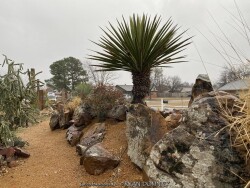
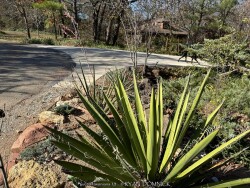

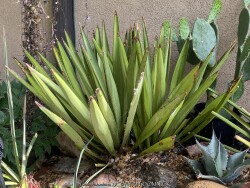

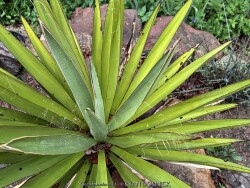
Plant Min Zone: 6a
Plant Max Zone: 10b
Sunlight: All Day Full Sun, Full Sun
Water / Rainfall: Very Low
Soil Quality: Poor
Bloom Season: Summer
Flower Color: White
Berry / Fruit Color: None
Spring Foliage Color: Green
Summer Foliage Color: Green
Fall Foliage Color: Green
Evergreen Foliage: Yes
Winter Interest: Yes
Scented Flowers: No
Drought Tolerance: High
Wet-Feet Tolerance: Low
Humidity Tolerance: Low, Medium
Wind Tolerance: High
Poor Soil Tolerance: Sandy Soils, Rocky Soils, Alkaline Soils (high PH)
Height: 4' - 8'
Width: 1.5' - 3'
Growth Rate: Extremely Slow
Service Life: Long: 5-10 years
Maintenance Need: Almost Zero Maintenance
Spreading Potential: Extremely Low
Yearly Trimming Tips: Yuccas and Cacti Need No Trimming Except to Remove the Dead Flower Stalk.
Plant Grouping Size: Specimen Planting of 1-3
Best Side of House: South Exposure, West Exposure
Extreme Planting Locations: Survives Under Roof Overhang, Survives Severe Drought, Tolerates Extreme Heat, Resistant to Rabbits, Crevice Gardens
Ornamental Features: Multiple Seasons of Interest, Bright Winter Color, Fine Texture, Exceptional / Colorful Foliage
Special Landscape Uses: None
Possible Pest Problems: Root Rot Disease
Plant Limitations: May get Occasional Winter-kill, Has Thorns, Needs Excellent Drainage, Slow to Reach Mature Size
Shippable in 2026: YES
Bright green sword-like leaves from this yucca (Yucca faxoniana) make an excellent architectural statement. Used as a patio plant in Kansas, place in full sun with no extra watering except from rainfall. Repotting may or may not be needed depending on how large you want the plant to grow. Potted plants are hardy to at least 10 degrees F if kept dry so you can wait awhile to move these in for the winter. Then move into a cold garage, basement, or bright window over the winter with NO watering. Many yuccas, including this one, may also be grown from rhizomes, stem cuttings, or by digging offsets from the side of established plants. Having desert heritage, it resents poor drainage and winter moisture. To counteract that in Kansas, plant in full sun on berm with poor sandy or rocky soil with no irrigation. ADDITIONAL INFORMATION ABOUT CREVICE GARDENING: In nature, some of the most interesting xeric plants grow in tough places such as inhospitable rock outcroppings with almost no soil. We can recreate that specific and exclusive growing environment with a crevice garden. Crevice gardening allows you to grow cold-hardy cacti and succulents that are normally cold hardy to our climate (Lawrence, KS zone 6a) but not normally tolerant of excessive moisture (40"/year), especially in the winter. This technique provides optimal xeriscape growing conditions by limiting the amount of soil and water around the roots and reducing the potential of root rot. Start with a raised mound of fast draining soil mix consisting mostly of decomposed granite, coarse sand, gravel, and a small amount of organic matter. Incorporate vertical rock formations such as flagstone into a raised landscape bed creating narrow 1-2" wide crevices filled with the soil mix. This helps quickly channel rain and snow melt water down more deeply into the soil encouraging deeper root growth while keeping the soil dry around the base of the plant. It is important that the entire mound is well above grade level to avoid drainage problems; crevice gardens typically range from 12"-36" tall. After installing the plants, mulch with a thin layer of pea-gravel or decomposed granite. In our Lawrence Kansas zone 6a winters with occasional polar vortexes or arctic blasts, this technique works well in any hot microclimate such as a south facing side of a berm or under a south or west facing roof overhand of a house or building. Kansas Plant Farm LLC built a trial crevice garden in 2022 and we have now had enough time to evaluate the plants after a true winter cold spell. During the arctic blast of January 2024, low nighttime temperatures got down to -11 degrees F (Jan 10th,2024). The longevity of this cold blast was also impressive: 4 days on a row with single digit highs including 1 day with a daytime negative high(-2F), 4 nights of lows in negatives (-8For lower), and 48 straight hours of 0 degrees F and mostly lower. A light snow cover helped insulate the ground but wind blew off most powdery snow on the foliage exposing the top parts of the plants to some extreme temperatures with surprisingly little damage. In our crevice trial gardens in Lawrence, KS (zone 6a), this variety survived a harsh winter so far. Hardiness also confirmed at Denver Botanical Gardens (zone 5b) with several tree-like specimens in protected microclimates near concrete walls.